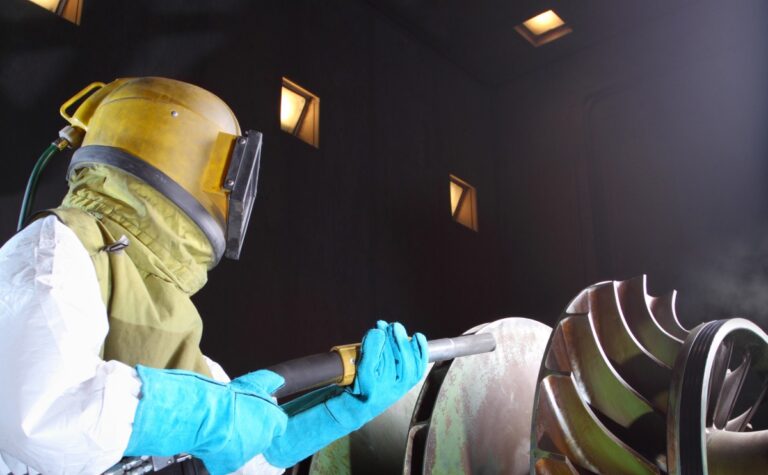Dust Collection for Abrasive Blasting
Regardless of its uses, there are only two basic methods of blasting – wet or dry with the major focus for dust control being of this summary will be on the dry blasting method.

Abrasive Blasting Overview
Abrasive blasting or blast finishing, with all its variations, can provide enough power to remove heavy surface materials, or can be gentle enough to take print off paper without penetration. Typically, blasting provides one of three general – as a surface finishing, surface preparation, or surface modification process.
Abrasive Blasting Applications
Surface Finishing Process:
- Removing surface contamination
- Creating a specific finish on a desired surface
Surface Preparation Process:
- Roughening surfaces for the application of paint
- Removing surface irregularities
Surface Modification Process
It Increases Compressive Stresses on the Surface:
- Providing increased fatigue life
- Decreasing susceptibility to stress corrosion
- Correcting distortion
- Forming structural steel and plate.
Dust Collection Considerations
Common Applications / Equipment in dry blasting and Shot Blast
These are common applications and equipment used in dry blasting and shot blast applications: Manual Cabinet, Rotary Basket, Rotary Table, Automated Feed Booths, Tumblers, Barrels, Oscillation Units, and Blast Rooms
Feed Materials
Dust collection equipment selection must consider particulate from both the blasted material blasting material. The blasted materials can make up as much as 95% of the collected contaminate in the dust collector so fire, explosion, corrosive, or toxic considerations for the blasted material may define requirements for a specific application. The consideration of the media used in dry blasting processes can vary with facilities and on a daily basis within a specific facility. The media used ranges in size from 20 to 6000 mesh and the style of blasting will determine the size of particulate collected.
Blasting Styles
Styles of dry blasting, will determine the loading conditions of the dust collector.
Direct pressure provides a uniform finish in a short time, and offers more precise system controls, making the machines appropriate for heavy finishing jobs. This style removes heavy mill scale or paint, reaches hard-to-reach areas, odd shapes, large workpieces, and high-speed production. Consequently, heavy grain loading must be taken into consideration in dust collection
Induction (suction) is used for light to medium production, limited space, and/or where moderate budget requirements exist. Some pressure is lost to the media suction requirement; therefore, it is less efficient than direct pressure style. Usually reserved for cabinet type blasting units, this style does not generate high grain loading. However, if multiple cabinets are exhausted, grain loading can increase significantly and must be considered in dust collection.
The Airless or Blast Wheel are used in heavy production requirements where the need for automated systems and minimal human interface. Parts come to the blast machine either by mechanical coney or are loaded manually into the blast machine. Due to the amount of blast media used, these machines can produce heavy grain loading conditions which needs to be considered in dust collections
Dust Collection Strategy
Keep hoods as far from the actual blasting process as possible, but maintain proper removal of the contaminant from the blasting area. There are two advantages to keeping the collection hood at a distance:
- reduce the possibility of clean or good blast media entering the dust collector
- reduce the effects of abrasion in the collector, as only dust is collected
Dust Collector Air Inlet Placement
Have air enter the dust collector through one of the following inlet types. (Remember blast media removes material or alters a surface, and it will do the same thing to the dust collector and filter elements.)
- Abrasion Resistant (A/R) Inlet,
- Drop-out box,
- Duct tapered to full inlet dimensions
- Consider options to reduce collector media abrasion,
- Abrasion Resistant Liner, or
- Cyclone Prefilter
Blast Media Volume
Dust loading to the collector plays a large part in how the collector performs. Even when blast media is not the most abrasive, a large volume can prove fatal to filter elements. Again, consider inlet conditions to reduce dust loadings to the collector.
Considerations for Volumetric Flow Rate
Determining a volumetric flow rate for a blasting process involves the review of the blasting equipment used, the blasted material, the blast media, and any specific customer requirements. Typical objectives are visible clarity, dust containment, and/or cross draft velocities.
Visible Clarity
Visible clarity requests often define the frequency of system air exchanges in a given volume. These requests are usually associated with the time it takes the blasting environment to become visually impaired. Recommendations of 60-100 cfm/ft2 of floor or ceiling and 100 cfm/ft2 of wall space are common. Typical cabinet blasting recommendations are 20 air changes per minute.
Dust Containment
Dust containment requests are associated with cabinet or automated blasting processes. Air volumes are determined based on the velocities necessary through open areas to prevent dust from escaping the enclosure. Cabinet recommendations of 500 fpm through the open areas are common. For rotary tables, use 200 cfm/ft2 of opening.
Cross Draft Velocity
Cross Draft velocity requirements are associated with blast rooms, and collector size is based on a given velocity across a given cross sectional area. Common recommendations are 150-200 fpm through the room, across the work piece, away from the worker(s).
Special considerations for the material blasted are important. Blasting materials that are explosive, flammable, corrosive, or toxic means precautions are necessary for the dust collector.
Notes:
- Special considerations for the material blasted are important. Blasting materials that are explosive, flammable, corrosive, or toxic means precautions are necessary for the dust collector.
- Most blast media is used several times with only 5% – 8% of the media “spent” during a single blast sequence. Consider the material blasted with every application being careful not to mix incompatible materials in the same collector.
- Blast media is abrasive, so apply abrasion-reducing features with each collector.
- Due to the extremely wide variety of materials blasted, the various blast media available, and the differences in styles of blasting, not all applications are addressed in this report.
Resources
Definitions:
- Media – Substance used in an abrasive blasting operation. Media may be in granular, powder, pellet, or shard form depending upon specific customer requirements.
- Abrasive Blasting – The forcible application of an abrasive media to a surface by pneumatic pressure, hydraulic pressure, or centrifugal force.
- Blast cleaning barrel – A complete enclosure which rotates on an axis, or which has an internal moving tread to rumble the parts, in order to expose various surfaces of the part to the action of the blast spray.
- Blast cleaning room – A complete enclosure in which blasting operations are performed and where the operator works inside of the room to operate the blasting nozzle and direct the flow of the abrasive material.
- Blasting cabinet – An enclosure where the operator stands outside and operates the blasting nozzle through an opening or openings in the enclosure.
- Rotary blast cleaning table – An enclosure where the pieces to be cleaned are positioned on a rotating table and are passed automatically through a series of blast sprays.
Related Articles
Related Products
Legislation
Additional Federal & Local Legislation May Also Apply
US EPA
Particulate Matter (PM):
– PM 2.5 = 15 µg/m3 (annual), and 35 µg/m3 (24-hour)
– PM 10 = 150 µg/m3 (24-hour)
OSHA Regulations
– Directive CPL 03-00-007: National Emphasis Program – Crystalline Silica Jan 24, 2008.
– 29 CFR 1910.94
– 29 CFR 1910.1000
– 29 CFR 1910.1000 – Air Contaminants
NOTE: Twenty-five states, Puerto Rico and the Virgin Islands have OSHA-approved State Plans and have adopted their own standards and enforcement policies. For the most part, these States adopt standards that are identical to Federal OSHA. However, some States have adopted different standards applicable to this industry or may have different enforcement policies.
References
Industrial Ventilation Manual
NIOSH Publication No. 76-179
WAC 296-818-500
AP-42, ch 13.2.6: Abrasive Blasting

AST Canada has been helping clients find solutions for their unique Dust, Mist & Fume Collection needs for more than 40 years.
We can help you too.

